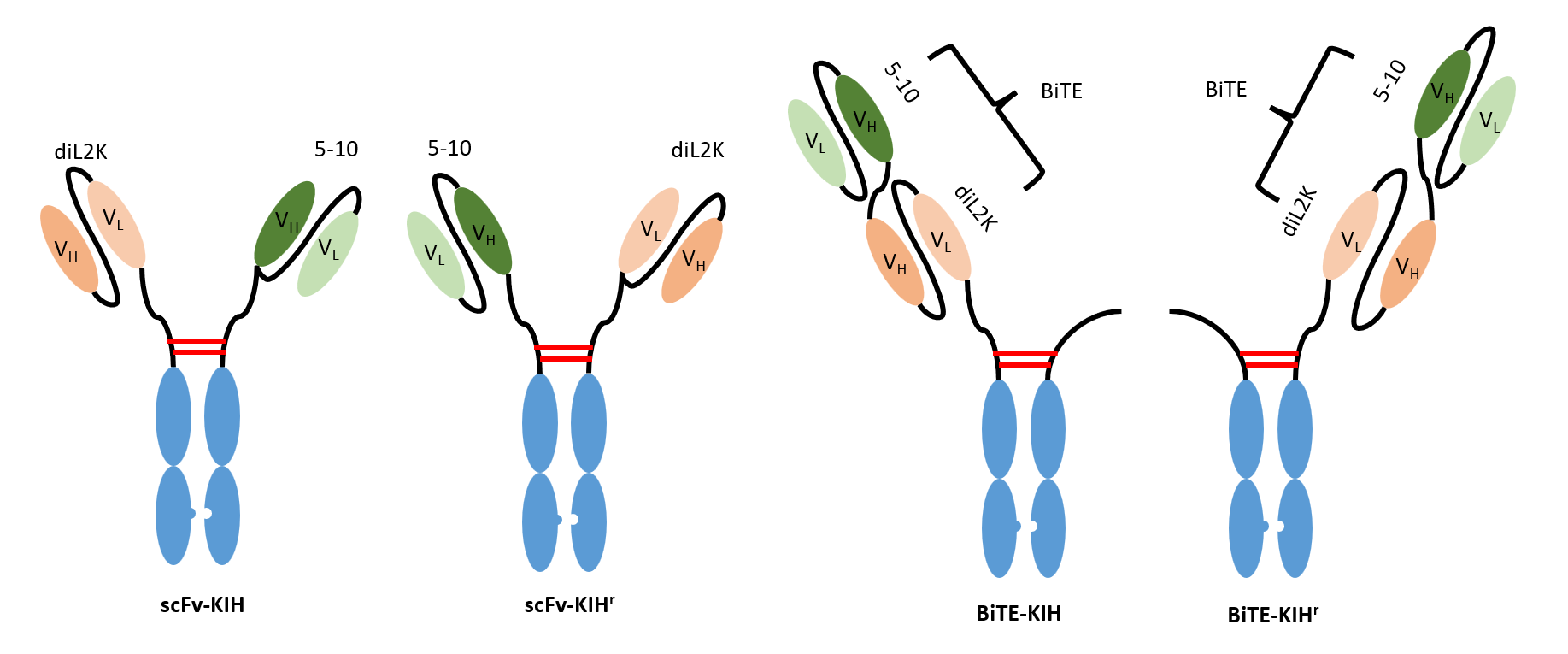What is scFv-CH3 KIH?
scFv-CH3 KIH is a bispecific antibody composed of two chains, each containing an scFv and a CH3 domain. The scFv is a single-chain variable fragment that can recognize and bind to antigens, while the CH3 domain is the third structural domain of the constant region of human IgG1, which can regulate Fc functions. scFv-CH3 KIH uses the Knob-into-hole (KiH) technology, which introduces complementary structures of protrusions and holes on the CH3 domains, to promote the formation of heterodimers between the two chains. scFv-CH3 KIH possesses bivalent binding ability, allowing it to target two different antigens simultaneously or two different epitopes of the same antigen, thereby enhancing affinity and specificity. Furthermore, scFv-CH3 KIH retains Fc functions, such as antibody-dependent cellular cytotoxicity, complement-dependent cellular cytotoxicity and prolonged half-life. The advantages of scFv-CH3 KIH include its simple design, efficient expression, stable structure, easy purification, and biocompatibility. However, there are some disadvantages, such as the low stability of the scFv portion, incomplete formation of heterodimers, and the potential for immunogenicity.
Generation Methods of scFv-CH3 KIH
scFv-CH3 KIH can be generated using two main methods: genetic engineering and chemical conjugation. Genetic engineering involves constructing the coding sequence of scFv-CH3 KIH at the DNA level, followed by expression and secretion scFv-CH3 KIH in host cells. This method allows for the obtainment of complete Fc functions, highly consistent structures and lower production costs. However, it requires optimization of the connection mode between the scFv and CH3 domains, control of heterodimer formation efficiency, and resolution of the stability issues related to the scFv portion.

Fig.1 KIH Scaffolds
Chemical conjugation is another method that involves introducing cross-linkable groups onto purified monospecific antibodies and chemically reacting them under appropriate conditions to form scFv-CH3 KIH. This method enables the use of existing monospecific antibodies, improves the stability of the scFv part, and allows for flexible adjustment of the ratio of bispecific antibodies. However, it requires complex purification steps, may affect Fc functions and biocompatibility and increase production costs.
Clinical Data of scFv-CH3 KIH
scFv-CH3 KIH is primarily employed for cancer treatment in clinical settings, targeting two different molecules simultaneously on the surface of cancer cells or within the tumor microenvironment to achieve synergistic anti-tumor effects. Currently, several scFv-CH3 KIH antibodies have been approved or are undergoing clinical trials. Here are some representative examples:
One of the approved scFv-CH3 KIH is a bispecific antibody that targets HER1 and HER3, simultaneously inhibiting the signal transduction of these two receptor tyrosine kinases, thereby blocking the growth and survival of tumor cells. In phase III clinical trials, this antibody showed significant anti-tumor activity and good safety. Compared with erlotinib, it significantly prolonged progression-free survival and overall survival. Currently, this antibody is the only approved bispecific antibody for treating advanced non-small cell lung cancer, providing a new treatment option for patients in this group.
Some of the scFv-CH3 KIH antibodies undergoing clinical trials target PD-1 and LAG3, CD19 and CD3, or CD20 and CD3. These antibodies simultaneously activate two immune checkpoint inhibitors, or recruit and activate T cells to eliminate B cell malignancies. In phase I/II clinical trials, these antibodies exhibited favorable tolerability and efficacy. Compared with monospecific antibodies, they improved the objective response rate and durable response rate in certain patients. These antibodies represent the most advanced PD-1 x LAG3, CD19 x CD3 or CD20 x CD3 bispecific antibodies in clinical trials, providing a new therapeutic strategy for immunotherapy-resistant or refractory cancer patients.
Table 1. scFv-CH3 KIH in Clinical Trials
|
Target
|
Clinical Trial Phase
|
Led by Which Companies/Institutions
|
|
PD-1 x LAG3
|
I/II
|
Sanofi, National Cancer Institute etc.
|
|
CD19 x CD3
|
I/II
|
Sanofi, National Cancer Institute etc.
|
|
CD20 x CD3
|
I/II
|
Sanofi, National Cancer Institute etc.
|
References
1. Brinkmann U, et al. The making of bispecific antibodies. MAbs. 2017;9(2):182-212.
2. Choi HJ, et al. A heterodimeric Fc-based bispecific antibody simultaneously targeting VEGFR-2 and Met exhibits potent antitumor activity. Mol Cancer Ther. 2013;12(12):2748-59.
3. Fan G, et al. Bispecific antibodies and their applications. J Hematol Oncol. 2015;8:130.
4. Kontermann RE. Dual targeting strategies with bispecific antibodies. MAbs. 2012;4(2):182-97.
5. Lewis SM, et al. Generation of bispecific IgG antibodies by structure-based design of an orthogonal Fab interface. Nat Biotechnol. 2014;32(2):191-8.
6. Ridgway JB, et al. "Knobs-into-holes" engineering of antibody CH3 domains for heavy chain heterodimerization. Protein Eng. 1996;9(7):617-21.
7. Schaefer W, et al. Immunoglobulin domain crossover as a generic approach for the production of bispecific IgG antibodies. Proc Natl Acad Sci U S A. 2011;108(27):11187-92.
8. Xu Y, et al. Production of bispecific antibodies in "knobs-into-holes" using a cell-free expression system. MAbs. 2015;7(1):231-42.
Our products and services are for research use only, and not for use in diagnostic or therapeutic procedures.
Welcome! For price inquiries, we will get back to you as soon as possible.
To order, please email
INQUIRY





